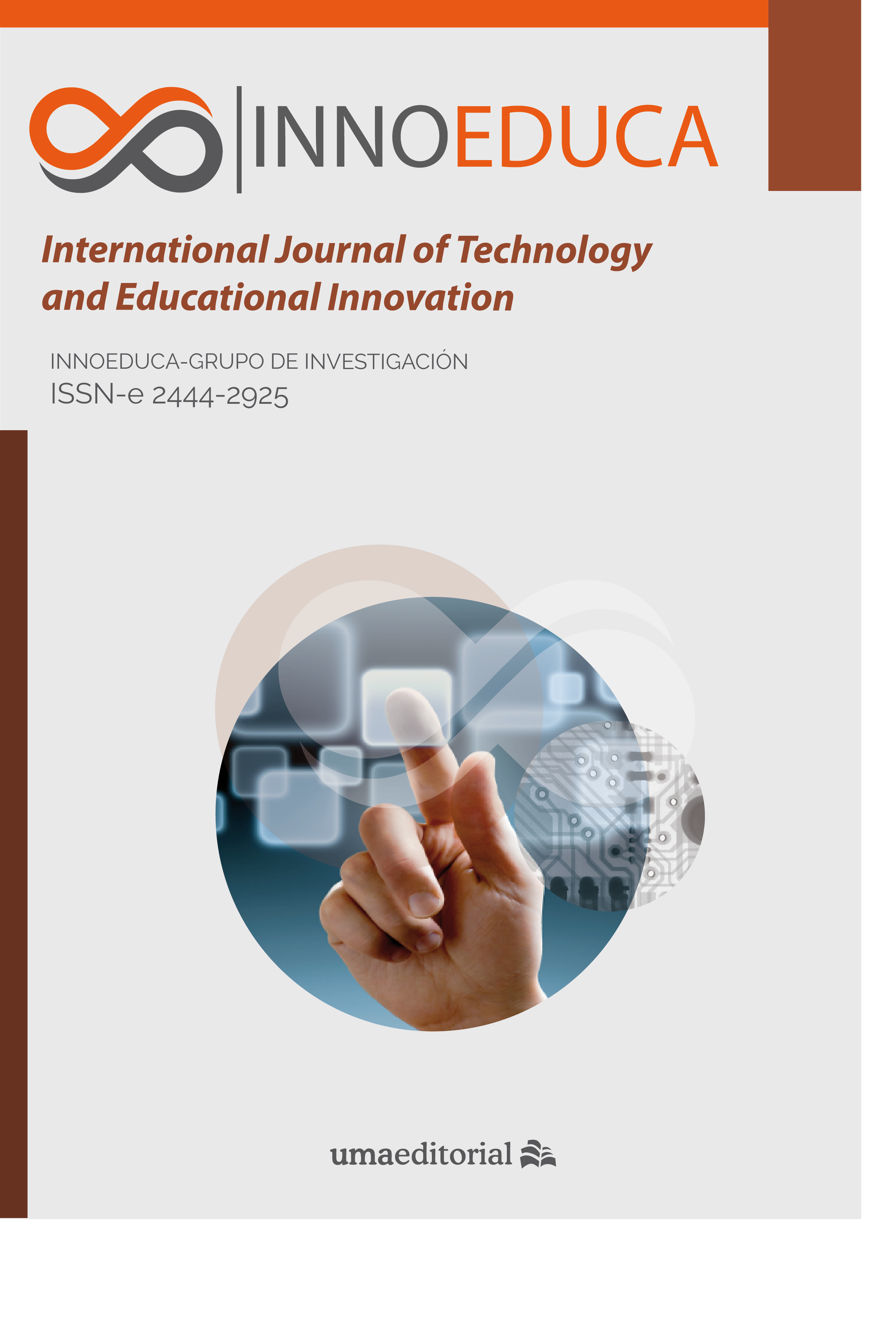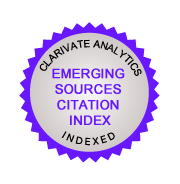Train and motivate girls for their future participation in the ICT sector. Proposal from five countries
DOI:
https://doi.org/10.24310/innoeduca.2020.v6i2.6256Keywords:
digital competence, gender stereotypes, didactic methods, stem, secondary education,, genderAbstract
Currently we observe how the digital gender gap in access, use and training in Information and Communication Technologies (ICT) is present from the first years of life of boys and girls, being, adolescence, the stage where it affects important future decisions. . In this paper we present the contributions for educational integration in adolescence, generated within the framework of the European project "TIC Go Girls!", aimed at breaking with gender stereotypes in the use of ICTs and making girls capable of take advantage of employment opportunities in the ICT sector. The results show that we have managed to break with stereotypes and promote in girls a deep reflection on their professional future. With the Project we provide a useful methodology so that schools and educational communities have been this initiative in an autonomous way.
Downloads
Metrics
References
Abbiss, J. (2011). Boys and machines: Gendered computer-identities, regulation and resistance. Gender and Education, 23, 601–617. DOI: https://doi.org/10.1080/09540253.2010.549108
Casado, C., Meneses, J. y Sancho, T. (2016). ¿Cómo ven los alumnos de primaria la profesión informática? Influencia del género y la percepción de su capacidad. Píxel-Bit. Revista de Medios y Educación, 49, 149-161. DOI: http://dx.doi.org/10.12795/pixelbit.2016.i49.010
Castaño, C. (Dir.) (2008). La Segunda Brecha Digital. Madrid: Ed. Cátedra.
Cussó, R (2014) Género y actitudes ante las TIC: estudio de la influencia del uso de ordenadores personales en los centros escolares. Recuperado de: http://repositori.udl.cat /bitstream/handle/ 10459 .1/56849/rcussoc.pdf?sequence=1&isAllowed=y
Drury, B. J., Siy, J. O., y Cheryan, S. (2011). When do female role models bene?t women? The importance of differentiating recruitment from retention in STEM. Psychological Inquiry: An International Journal for the Advancement of Psychological Theory, 22, 256–269. DOI: https://doi.org/10.1080/1047840X.2011.620935
Fernández-Morante, C. y Cebreiro, B. (2013). ICT Go Girls! : promoviendo el emprendimiento con TIC entre las alumnas de secundaria. En Sánchez, J.; Ruiz, J. y Sánchez, E. (Coords.). Buenas prácticas con TIC en la investigación y la docencia. Málaga, Universidad de Málaga.
García, I.; Gros, B. y Escofet, A. (2012). La influencia del género en la cultura digital del estudiantado universitario. Athenea Digital, 12(3), 95-114. DOI: https://doi.org/10.5565/rev/athenead/v12n3.1075
Gargallo, B.; Suárez, J. y Belloch, C. (2003). La división digital en el proceso de integración de las NTIC en la educación. Diferencias de género entre alumnos de E.S.O. de la comunidad valenciana. Teoría de la Educación, 4. Recuperado de: http://campus.usal.es/~teoriaeducacion/rev_ numero_ 04/n4_art_gargallo-suarez-belloch.htm
Gil-Juarez, A., Vitores, A., Feliu, J.y Vall-Llovera, M. (2011). Brecha digital de género: Una revisión y una propuesta. Education In The Knowledge Society (EKS), 12(2), 25-53. Recuperado de: http://revistas.usal.es/index.php/revistatesi/article/view/8272/8291
Heemskerk, I., Geert ten Dam, Volman, M. y Admiraal, W. (2014). Gender Inclusiveness in Educational Technology and Learning Experiences of Girls and Boys. Journal of Research on Technology in Education, 41(3). DOI: https://doi.org/10.1080/15391523.2009.10782531
Hadjar, A. y Aeschlimann, B. (2015). Gender Stereotypes and Gendered Vocational Aspirations among Swiss Secondary School Students. Educational Research, 57(1), 22-42. DOI: https://doi.org/10.1080/00131881.2014.983719
Lang, C., Fisher, J., Craig, A. y Forgasz, H. (2015) Outreach programmes to attract girls into computing: how the best laid plans can sometimes fail, Computer Science Education, 25(3), 257-275. DOI: 10.1080/08993408.2015.1067008
Lasen, M. (2010). Education and career pathways in information communication technology: What are schoolgirls saying? Computers & Education, 54, 1117–1126. DOI: DOI: https://doi.org/10.1016/j.compedu.2009.10.018
Leiva Olivencia, J. (2016). Santos Rego, M. Á. (ed.) (2015) El poder de la familia en la educación. Madrid, Editorial Síntesis. Teoría de la Educación. 28 (1), 259-262. Recuperado de: http://revistas.usal.es/index.php/1130-3743/article/view/14778/15291
Lepi"nik, J. y Samec, P. Uso de tecnologías en el entorno familiar en niños de cuatro años de Eslovenia. Comunicar: Revista científica iberoamericana de comunicación y educación, 40, 119-126. DOI: http://dx.doi.org/10.3916/C40-2013-03-02
Master, A., Cheryan, S. y Meltzoff, A. (2016). Computing Whether She Belongs: Stereotypes Undermine Girls' Interest and Sense of Belonging in Computer Science. Journal of Educational Psychology, 108 (3), 424-437. DOI: http://dx.doi.org/10.1037/edu0000061
Margolis, J., y Fisher, A. (2002). Unlocking the clubhouse: Women in computing. Cambridge: MIT Press.
Miliszewska, I. y Moore, A. (2011) Attracting Girls to ICT studies and careers: A snapshot of Strategies. Redress: Association of Women Educators, 20 (3) 10-14). Recuperado de: http://vuir.vu.edu.au/id/eprint/9176
Rodríguez, M., Peña, J., y García, O. (2016). Estudio cualitativo de las diferencias de género en la elección de opciones académicas en los estudiantes del bachillerato científico-técnico. Teoría de la Educación. 28, (1), 189-207. Recuperado de: http://revistas.usal.es/index.php/1130-3743/article/view/teoredu2016281189207/15277
Rodríguez, MJ., Ilijic, B., Fernández-Morante, C., Cebreiro, B. y Wolf, B. (2014): Manual para Centros Educativos. Promoviendo el espíritu emprendedor a través de las TIC. Recuperado de: www.cesga.es/es/noticias/descargaDocumento/id/193
Sáinz, M. y Müller, J. (2018). Gender and family influences on Spanish students’ aspirations and values in stem fields. International Journal of Science Education, 40, (2). DOI: https://doi.org/10.1080/09500693.2017.1405464
Sáinz, M., Meneses, J., López, B. y Fàbregues, S. (2016): Gender Stereotypes and Attitudes Towards Information and Communication Technology Professionals in a Sample of Spanish Secondary Students. Sex Roles. A Journal of Research, 74, (3-4), 154-168. Recuperado de: https://link.springer.com/article/10.1007/s11199-014-0424-2
Sánchez, N., Ortega, O. y Vall-Llovera, M. (2012). Romper la brecha digital de género. Factores implicados en la opción por una carrera tecnológica. Athenea Digital. 12(3), 115-128. DOI: https://doi.org/10.5565/rev/athenead/v12n3.1133
Scantlebury, K., y Baker, D. (2007). Gender issues in science education research: Remembering where the difference lies. In S. Abell & N. Lederman (Eds.), Handbook of research on science education (pp. 257–286). Mahwah, NJ: Lawrence Erlbaum.
Tiainen, T. y Berki, E. (2017). The re-production process of gender bias: a case of ICT professors through recruitment in a gender-neutral country. Studies in Higher Education. DOI: 10.1080/03075079.2017.1351428
Tatli, Z. (2018). Traditional and Digital Game Preferences of Children: A CHAID Analysis on Middle School Students. Contemporary Educational Technology, 9(1), 90-110. Recuperado de: https://files.eric.ed.gov/fulltext/EJ1166435.pdf
Varma, R. (2010). Why so few women enroll in computing? Gender and ethnic differences in students’ perception. Computer Science Education, 20, 301–316. DOI: https://doi.org/10.1080/08993408.2010.527697
Vekiri, I. (2013). Information science instruction and changes in girls’ and boys’ expectancy and value beliefs: In search of gender-equitable pedagogical practices. Computers & Education, 64, 104–115. DOI: 10.1016/j.compedu.2013.01.011
Verges, N. (2012). De la exclusión a la autoinclusión de las mujeres en las TIC. Motivaciones, posibilitadores y mecanismos de autoinclusión. Athenea Digital, 12(3), 129-150. DOI: https://doi.org/10.5565/rev/athenead/v12n3.1042
Downloads
Published
How to Cite
Issue
Section
License
All contents published by Innoeduca. International Journal of Technology and Educational Innovation are subject to Creative Commons Attribution-Nocomercial-NoDerivatives 4.0 International License, whose complete text can be consulted at https://creativecommons.org/licenses/by-nc-nd/4.0/legalcode. Thus, copying, distribution, public communication, derivative works and commercial use of content are permitted as of the aforementioned issue provided that the source and the author of the text are cited.
It is the responsibility of the authors to obtain the necessary permits for images that are subject to copyright.

This work is licensed under a Creative Commons Attribution-NonCommercial-NoDerivatives 4.0 International License.









1.jpg)


242.png)








